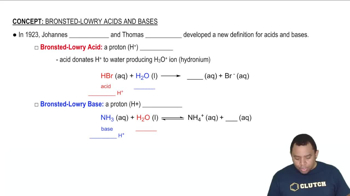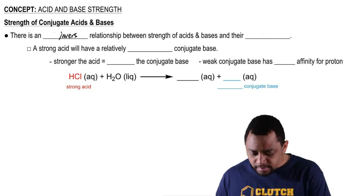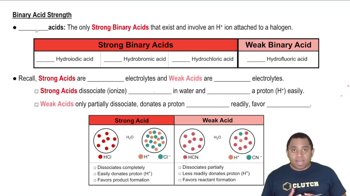Label each of the following as being a strong base, a weak base, or a species with negligible basicity. In each case write the formula of its conjugate acid, and indicate whether the conjugate acid is a strong acid, a weak acid, or a species with negligible acidity: (e) NH3.
Ch.16 - Acid-Base Equilibria
Chapter 16, Problem 24
Which of the following is the stronger Brønsted–Lowry acid, HClO3 or HClO2?
 Verified step by step guidance
Verified step by step guidance1
Identify the Brønsted–Lowry acid: A Brønsted–Lowry acid is a substance that donates a proton (H⁺) in a chemical reaction.
Compare the structures: HClO₃ (chloric acid) and HClO₂ (chlorous acid) differ in the number of oxygen atoms bonded to the central chlorine atom.
Consider the effect of oxygen atoms: More oxygen atoms increase the acid strength due to the inductive effect, which stabilizes the conjugate base by delocalizing the negative charge.
Analyze the inductive effect: HClO₃ has more oxygen atoms than HClO₂, which means it has a stronger inductive effect, leading to a more stable conjugate base.
Conclude the comparison: Based on the number of oxygen atoms and the inductive effect, HClO₃ is the stronger Brønsted–Lowry acid compared to HClO₂.
Key Concepts
Here are the essential concepts you must grasp in order to answer the question correctly.
Brønsted–Lowry Acid-Base Theory
The Brønsted–Lowry theory defines acids as proton donors and bases as proton acceptors. This framework allows for the classification of substances based on their ability to donate or accept hydrogen ions (H+). Understanding this theory is essential for comparing the strength of acids, as stronger acids are more effective at donating protons.
Recommended video:
Guided course

Bronsted-Lowry Acid-Base Theory
Acid Strength and Conjugate Bases
The strength of an acid is often determined by its ability to dissociate in solution and the stability of its conjugate base. A stronger acid will have a weaker conjugate base, which is less likely to re-accept the proton. In the case of HClO3 and HClO2, analyzing the stability of their respective conjugate bases (ClO3- and ClO2-) is crucial for determining which acid is stronger.
Recommended video:
Guided course

Strength of Conjugate Acids and Bases
Oxidation State and Acid Strength
In oxyacids, the oxidation state of the central atom can influence acid strength. Generally, as the oxidation state of the central atom increases, the acid strength also increases due to the greater positive charge, which stabilizes the conjugate base after proton donation. This concept is particularly relevant when comparing HClO3 (where Cl is in a higher oxidation state) to HClO2.
Recommended video:
Guided course

Binary Acid Strengths
Related Practice
Textbook Question
Textbook Question
Label each of the following as being a strong acid, a weakacid, or a species with negligible acidity. In each case write theformula of its conjugate base, and indicate whether the conjugatebase is a strong base, a weak base, or a species with negligiblebasicity: (a) HCOOH
Textbook Question
Which of the following is the stronger Brønsted–Lowry acid, HBrO or HBr?
1
views
Textbook Question
Predict the products of the following acid–base reactions, and predict whether the equilibrium lies to the left or to the right of the reaction arrow:
(a) O2-(aq) + H2O(l) ⇌
(b) CH3COOH(aq) + HS-(aq) ⇌
(c) NO2-(aq) + H2O(l) ⇌
Textbook Question
Predict the products of the following acid–base reactions, and predict whether the equilibrium lies to the left or to the right of the reaction arrow:
(a) NH4+(aq) + OH-(aq) ⇌
(b) CH3COO-(aq) + H3O+(aq) ⇌
(c) HCO3-(aq) + F-(aq) ⇌
